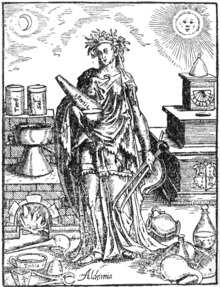Alkahest
[nb 1] It was supposed to be capable of dissolving any composite substance, including gold (then not considered an element), without altering or destroying its fundamental components.
[5] Anglo-Dutch alchemist and physician William Yworth (Cleidophorus Mystagogus) (died 1715) argued for its root originating from High Dutch.
[7] Other names include latex (or "clear water reduced to its minutest atoms"), and primum Ens Salum (or "salt exalted to its highest degree").
Its prevalence in the 17th and 18th centuries, despite its otherwise absurd and extreme qualities, was likely due to the popularity of alchemy at the time and the lack of an adequate alternative theory of chemistry.
[9][12] Moreover, Starkey believed that, because acid saline liquors are destroyed by alkalies and urinous spirits, they cannot be ingredients of the immortal alkahest.
[9][8] Starkey and his mentor Helmont (by their own report) used mercuric sulphide to dissolve gold, and informed Robert Boyle about it in a series of letters.
[8] Because of the supposed power of alkahest to break down substances into their occult qualities, it was sought after for its potential to cure incurable diseases at the time.
[7] Ladislaus Reti, a 20th-century historian of science, investigated alchemical recipes involving alkahest and found that no chemical was sufficient in breaking down the wide variety of materials Helmont supposed.
[9][13] According to Helmont and Anglo-Irish scientist Robert Boyle (1627–1691), the alkahest had a "microstructure", meaning it was composed of extremely small, homogeneous corpuscles.
[8] Tobias Ludwig Kohlhans (1624–1705) suggested in his dissertation of the spleen, that alkahest could be found in the liquid that had been discovered in the lymphatic vessels of animals.
[citation needed] In modern times, water is sometimes called the universal solvent, because it can dissolve a large variety of substances; more than any other liquid.
[15] Alkahest, Inc. is a biopharmaceutical subsidiary of Grifols which is developing products derived from blood plasma to reverse and inhibit aging.
